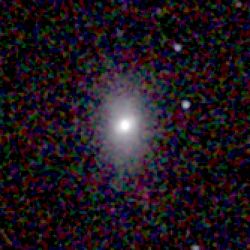NGC 7007 facts for kids
NGC 7007 is a fascinating galaxy located in a part of the sky called the Indus constellation. It's a special type of galaxy known as a lenticular galaxy. Imagine a galaxy that's a mix between a spiral galaxy (like our own Milky Way) and an elliptical galaxy (which is more like a big, round blob). That's a lenticular galaxy!
NGC 7007 is incredibly far away from Earth – about 130 million light-years! To give you an idea of how far that is, one light-year is the distance light travels in one year. Light travels super fast, so 130 million light-years is an enormous distance. This means the light we see from NGC 7007 today actually left the galaxy 130 million years ago, long before humans even existed on Earth!
Contents
What is a Lenticular Galaxy?
A lenticular galaxy is like a cosmic pancake without the spiral arms. It has a bright, round center, called a bulge, just like spiral galaxies. But unlike spiral galaxies, it doesn't have those beautiful, swirling arms made of stars, gas, and dust. Instead, it has a flat, disk-like shape, similar to a lens (which is where the name "lenticular" comes from).
Scientists believe that lenticular galaxies might have once been spiral galaxies that lost their gas and dust. This could happen if they used up all their gas to form new stars, or if they crashed into another galaxy, which stripped away their gas. Because they don't have much gas and dust left, lenticular galaxies don't form many new stars. Most of the stars in them are older.
Where is NGC 7007 Located?
NGC 7007 is found in the Indus constellation. A constellation is a group of stars that form a pattern in the night sky, often named after animals, mythological figures, or objects. The Indus constellation is named after the Indus River. It's a constellation that can be seen mainly in the Southern Hemisphere.
Even though NGC 7007 is in the direction of the Indus constellation, it's important to remember that the stars in a constellation are usually much closer to us than distant galaxies like NGC 7007. The constellation just helps us point to the general area of the sky where the galaxy can be found.
How Far Away is This Galaxy?
As we mentioned, NGC 7007 is about 130 million light-years away. This distance is truly mind-boggling! When astronomers look at this galaxy through powerful telescopes, they are essentially looking back in time. The light from NGC 7007 started its journey towards Earth when dinosaurs were still roaming our planet.
Studying galaxies that are so far away helps scientists understand how the universe has changed over billions of years. It also gives us clues about how galaxies form, evolve, and interact with each other across the vastness of space.
See also
 In Spanish: NGC 7007 para niños
In Spanish: NGC 7007 para niños


